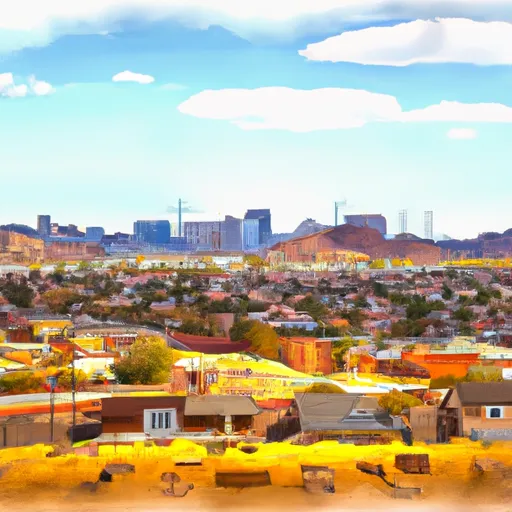-
 Snoflo Premium
Snoflo Premium
Get unlimited access to all our content
With no Ad interruptions! - Start Your Free Trial Login with existing account
Red-Valley
Eden Index
Climate
8.8
•
Recreation
•
Community
•
Safeguard
3.5/10

Red-Valley, Arizona is a small town nestled in the picturesque Red Valley region of the state. It experiences a semi-arid climate characterized by hot, dry summers and mild winters. Summers see average high temperatures in the 90s°F (32-37°C) and occasional monsoon rains, while winters are mild with highs in the 50s-60s°F (10-16°C). The area receives an average annual precipitation of around 12 inches (30 cm).
Hydrologically, Red-Valley benefits from the Little Colorado River, which flows nearby and provides a lifeline to the region. The river supports diverse flora and fauna and offers opportunities for outdoor enthusiasts. Fishing, boating, and rafting are popular activities along its course.
The surrounding Red Valley area presents abundant outdoor recreation opportunities. Hikers can explore scenic trails that wind through stunning canyons, offering breathtaking views of the unique red rock formations. Mountain biking and off-roading enthusiasts can find a variety of challenging terrain to explore. Wildlife watching, camping, and photography are also popular activities in the area.
Red-Valley, Arizona offers a delightful natural environment, making it an appealing destination for outdoor enthusiasts seeking adventure and tranquility in equal measure.
What is the Eden Index?
The Snoflo Eden Index serves as a comprehensive rating system for regions, evaluating their desirability through a holistic assessment of climate health, outdoor recreation opportunities, and natural disaster risk, acknowledging the profound impact of these factors on livability and well-being.
Climate Health Indicator (CHI): 8.8
Red-Valley receives approximately
214mm of rain per year,
with humidity levels near 64%
and air temperatures averaging around
12°C.
Red-Valley has a plant hardyness factor of
7, meaning
plants and agriculture in this region tend to thrive during the non-winter months.
By considering the ideal temperature range, reliable water supplies, clean air, and stable seasonal rain or snowpacks, the Climate Health Indicator (CHI) underscores the significance of a healthy climate as the foundation for quality living.
A healthy climate is paramount for ensuring a high quality of life and livability in a region, fostering both physical well-being and environmental harmony. This can be characterized by ideal temperatures, reliable access to water supplies, clean air, and consistent seasonal rain or snowpacks.
Weather Forecast
Streamflow Conditions
Upper San Juan
Area Rivers
Upper San Juan
Snowpack Depths
Upper San Juan
Reservoir Storage Capacity
Upper San Juan
Groundwater Levels
Recreational Opportunity Index (ROI):
The Recreational Opportunity Index (ROI) recognizes the value of outdoor recreational options, such as parks, hiking trails, camping sites, and fishing spots, while acknowledging that climate plays a pivotal role in ensuring the comfort and consistency of these experiences.
Access to outdoor recreational opportunities, encompassing activities such as parks, hiking, camping, and fishing, is crucial for overall well-being, and the climate plays a pivotal role in enabling and enhancing these experiences, ensuring that individuals can engage in nature-based activities comfortably and consistently.
Camping Areas
| Campground | Campsites | Reservations | Toilets | Showers | Elevation |
|---|---|---|---|---|---|
| Camp Asaayi | None | 7,517 ft | |||
| Wheatfields Lake | 25 | 7,316 ft |
Catastrophe Safeguard Index (CSI):
The Catastrophe Safeguard Index (CSI) recognizes that natural disaster risk, encompassing floods, fires, hurricanes, and tornadoes, can drastically affect safety and the overall appeal of an area.
The level of natural disaster risk in a region significantly affects safety and the overall livability, with climate change amplifying these risks by potentially increasing the frequency and intensity of events like floods, fires, hurricanes, and tornadoes, thereby posing substantial challenges to community resilience and well-being.
Community Resilience Indicator (CRI):
The Community Resilience Indicator (CRI) recognizes that education, healthcare, and socioeconomics are crucial to the well-being of a region. The CRI acknowledges the profound impact of these elements on residents' overall quality of life. By evaluating educational resources, healthcare accessibility, and economic inclusivity, the index captures the essential aspects that contribute to a thriving community, fostering resident satisfaction, equity, and social cohesion.

